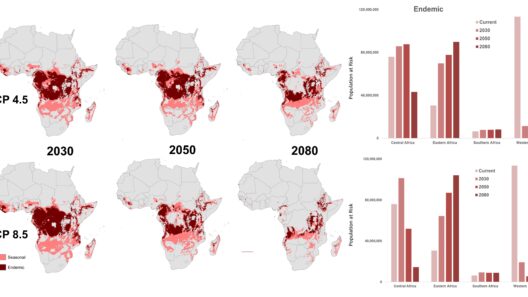Concrete, often regarded as the backbone of modern infrastructure, is subtly complicit in a narrative that is evolving into a climate crisis. Beneath the surface of its rugged texture lies a complex relationship with our planet’s health. In many ways, concrete can be seen as a double-edged sword. It is durable, versatile, and essential for building cities that house billions. Yet, this very material, while promising strength and stability, also bears an insidious responsibility—one that contributes to the escalating phenomenon of climate change.
The production of concrete is the third-largest source of carbon dioxide emissions globally, surpassed only by fossil fuel combustion and deforestation. Each year, the cement industry alone releases approximately 2.5 billion tons of CO2, a staggering statistic that poses a formidable challenge in our efforts to curtail global warming. To comprehend the profound impact of concrete, one must first understand its composition and the intricacies involved in its production.
At its most fundamental, concrete is a composite material, typically comprised of cement, aggregates, and water. When combined, these ingredients transform into a malleable mixture that solidifies into a formidable substance. Cement, the pivotal ingredient, is produced through a process known as calcination, wherein limestone is heated to roughly 1,450 degrees Celsius. This exothermic reaction not only releases CO2 but also consumes significant energy, predominantly derived from fossil fuels. Thus, concrete production initiates a vicious cycle, where the very material that builds our foundations simultaneously weakens the earth’s atmosphere.
Now, envision concrete as an aging giant, standing resolutely amidst the chaos of modern civilization. Its stoic façade belies the deterioration it invites upon itself and the environment. As urban development burgeons, the demand for concrete escalates, exemplifying a paradoxical relationship. The larger and more numerous the structures become, the greater the emissions accrued, compounding the challenges that climate change presents to our ecosystems.
Concrete’s environmental impact extends beyond its initial production. Its use in construction amplifies the heat absorption phenomenon, often referred to as the urban heat island effect. Cities enveloped in expansive concrete jungles experience elevated temperatures, which exacerbate issues such as increased energy consumption, heightened air pollution, and compromised public health. Urban areas serve as a testament to the paradox of progress—what was once hailed as an innovative solution now acts as a catalyst for deeper environmental dilemmas.
In light of these factors, it becomes paramount for architects, builders, and policymakers to consider alternative materials and sustainable practices that mitigate concrete’s overwhelming ecological footprint. Innovations such as recycled concrete aggregates and alternative binding agents like fly ash or slag can significantly reduce carbon emissions associated with traditional concrete production. This paradigm shift reflects a growing recognition of the importance of sustainability in construction, where the ethos of ‘reduce, reuse, recycle’ becomes more than just a catchphrase— it evolves into a fundamental principle guiding future developments.
Moreover, the advent of new methodologies, such as carbon capture and storage technology, provides promising avenues for curtailing emissions directly associated with cement production. As the industry grapples with its significant carbon footprint, embracing innovative solutions is not merely an option; it becomes an imperative.
Yet, the journey towards sustainable concrete usage does not merely rest on technological advancements; it requires a collective awakening to the moral obligations we owe to our planet. The commerce surrounding concrete must embrace transparency and accountability, encouraging stakeholders to evaluate the environmental consequences of their choices. By adopting a proactive stance towards eco-friendly alternatives, we aspire not only to reduce emissions but to foster a culture of environmental stewardship.
Furthermore, the public plays an indelible role in this transformation. Raising awareness and understanding of concrete’s impact on climate change can inspire individuals to advocate for greener initiatives in their communities. The very act of questioning the materials used in our surroundings can prompt an exploration of sustainable practices—and this dialogue is essential for driving progressive change.
It is essential to approach the conversation surrounding concrete with a sense of urgency. The ramifications of climate change are already rippling through our ecosystems, affecting biodiversity, weather patterns, and rising sea levels. As stewards of the earth, we must cultivate a symbiotic relationship with our environment, recognizing that the integrity of our built spaces should not compromise the health of our planet.
To transition from a narrative of destruction to one of rehabilitation requires bold action. It calls for a holistic, multifaceted response that integrates sustainable practices into every aspect of construction, from the materials procured to the labor employed. It is in our hands to dismantle the narrative of concrete as a mere building block of progress, reshaping it into a harbinger of sustainability and resilience.
In conclusion, the question lingers: Is your concrete contributing to climate change? The answer lies within our collective resolve to redefine our relationship with this ubiquitous material. By acknowledging its environmental consequences and seeking feasible, sustainable alternatives, we can transform concrete from a climate adversary into a cornerstone of a greener future. The journey begins with awareness, and with each informed choice, we lay the groundwork for a more sustainable existence.








